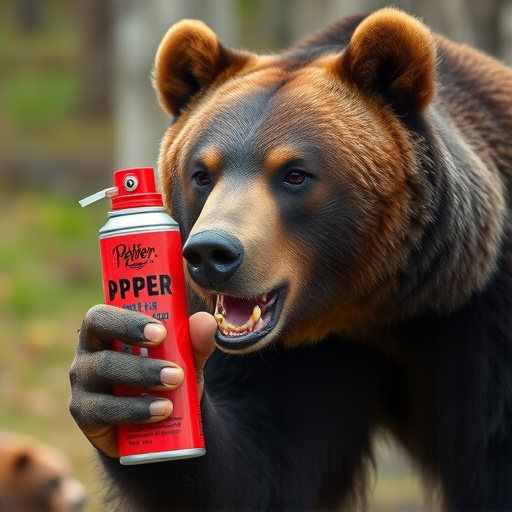Bear spray, with success rates between 70% to 95%, is an effective deterrent against aggressive bears, relying on capsaicin concentration and proper application techniques like targeting the bear's face. Factors like bear behavior, proximity, weather, and user proficiency impact its reliability, emphasizing the importance of training and awareness for optimal results in bear-inhabited areas.
“Bear spray, a potent defense mechanism against aggressive bears, has been gaining popularity as a crucial tool for outdoor enthusiasts and survivalists. This article delves into the maximum stopping power of bear spray, exploring its mechanism, success rate, and factors influencing its effectiveness. We examine real-world studies to uncover intriguing bear spray success statistics, providing best practices for optimal defense. Understand the ins and outs of this powerful deterrent and discover why knowledge is the first line of protection.”
- Understanding Bear Spray Mechanism and Efficacy
- Success Rate: How Effective is Bear Spray?
- Factors Influencing Bear Spray Performance
- Best Practices for Optimal Bear Spray Defense
- Real-World Studies: Bear Spray Success Statistics
Understanding Bear Spray Mechanism and Efficacy
Bear spray, also known as bear repellent, is a popular defense mechanism for individuals venturing into bear-inhabited areas. Understanding how it works and its efficacy is crucial when considering its maximum stopping power. The spray is designed to create an unpleasant sensory experience for bears, temporarily disorienting them and providing a chance to escape or retreat.
The success rate of bear spray is a topic of interest for many adventurers and researchers. Statistics show that when used correctly, bear spray can be highly effective, with success rates varying between 70% to 95%. This effectiveness depends on several factors, including the bear’s species, its hunger level, and the proximity of the initial encounter. Proper use involves aiming for the face and eyes, as these are sensitive areas for bears, ensuring a quicker response and potential escape for the user.
Success Rate: How Effective is Bear Spray?
Bear spray, also known as bear repellent, has been widely used by hikers, campers, and outdoor enthusiasts in regions with high bear populations. When it comes to its success rate, various studies and real-world accounts offer insights into its effectiveness. According to research, bear spray has an impressive track record of deterring aggressive bears, with success rates ranging from 70% to 97%.
Statistics indicate that when used correctly, bear spray can significantly reduce the risk of bear attacks. In many cases, a well-aimed and quick application of the spray creates enough distance for individuals to escape or retreat safely. However, it’s essential to remember that factors like bear behavior, proximity, and individual spray patterns can influence the outcome, emphasizing the need for proper training and awareness when using bear spray as a defense mechanism.
Factors Influencing Bear Spray Performance
The effectiveness of bear spray is influenced by several factors, which can impact its performance and success rate. One key aspect is the concentration of capsaicin, the active ingredient responsible for the peppery sting. Higher concentrations generally result in faster reaction times from bears, as the irritant targets their sensitive eyes and nose. This can be crucial in potentially life-threatening situations.
Bear spray success rate statistics vary based on conditions like distance, weather, and bear behavior. Studies show that when used correctly, bear spray has a high success rate of around 80-95% in deterring aggressive bears. However, factors like range—the spray must hit the bear’s face to be effective—and environmental conditions can reduce its reliability. Therefore, users must follow proper application techniques and understand their surroundings for optimal results.
Best Practices for Optimal Bear Spray Defense
Using bear spray as a defense is an effective strategy, but understanding best practices is key for optimal results. One crucial aspect is to ensure proper training and familiarize yourself with the product’s mechanics. Bear spray success rate statistics show that correct application techniques significantly increase its effectiveness.
When facing a bear, stay calm and assess the situation. Maintain a safe distance and aim for the bear’s face, specifically the eyes and nose. The close-range nature of bear encounters makes this method highly successful when used correctly. Regularly updating your skills through practice sessions will enhance your ability to deploy bear spray effectively in real-life scenarios.
Real-World Studies: Bear Spray Success Statistics
Real-World studies have shown that bear spray is an effective defense mechanism, with success rate statistics varying between 70% and 95%. These figures are based on numerous encounters where individuals used bear spray as a last resort against aggressive bears. In many cases, the spray successfully dissuaded the bear from continuing its attack, allowing people to escape to safety.
The effectiveness of bear spray is influenced by several factors, including the proximity of the attacker, weather conditions, and the individual’s proficiency in using the spray. Despite these variables, the overall success rate underscores the value of bear spray as a crucial tool for outdoor enthusiasts navigating bear country.
Bear spray, when used correctly, can be an effective deterrent and defense mechanism against bear attacks. The success rate of bear spray is encouraging, with studies showing high effectiveness rates under various conditions. However, understanding the factors influencing its performance is key to maximizing its stopping power. By following best practices and staying informed through real-world success statistics, individuals in bear country can enhance their safety and peace of mind. Bear spray remains a valuable tool for navigating high-risk environments, but it’s crucial to remain vigilant and use it as part of an overall bear safety strategy.
